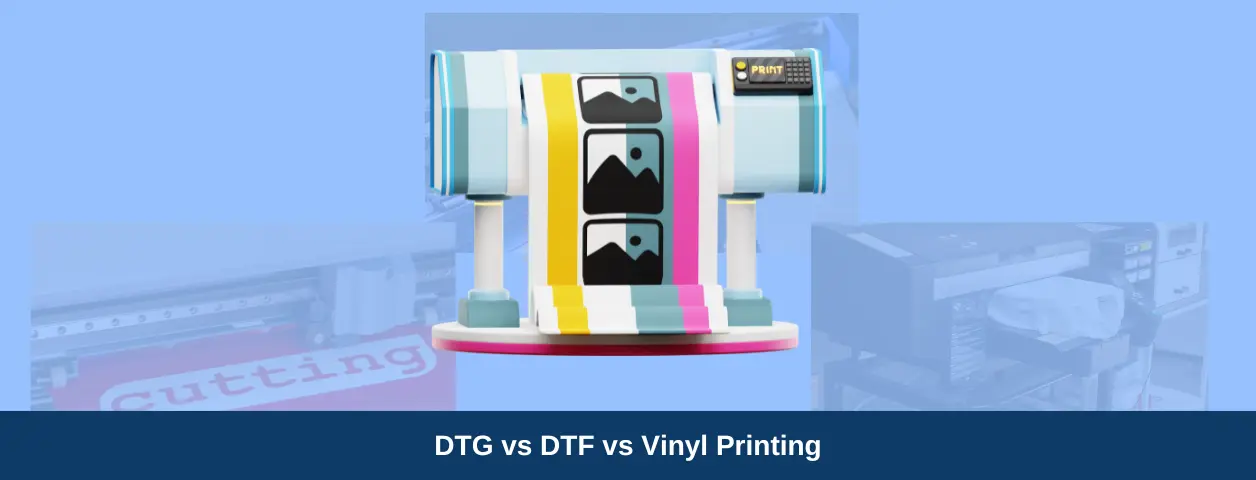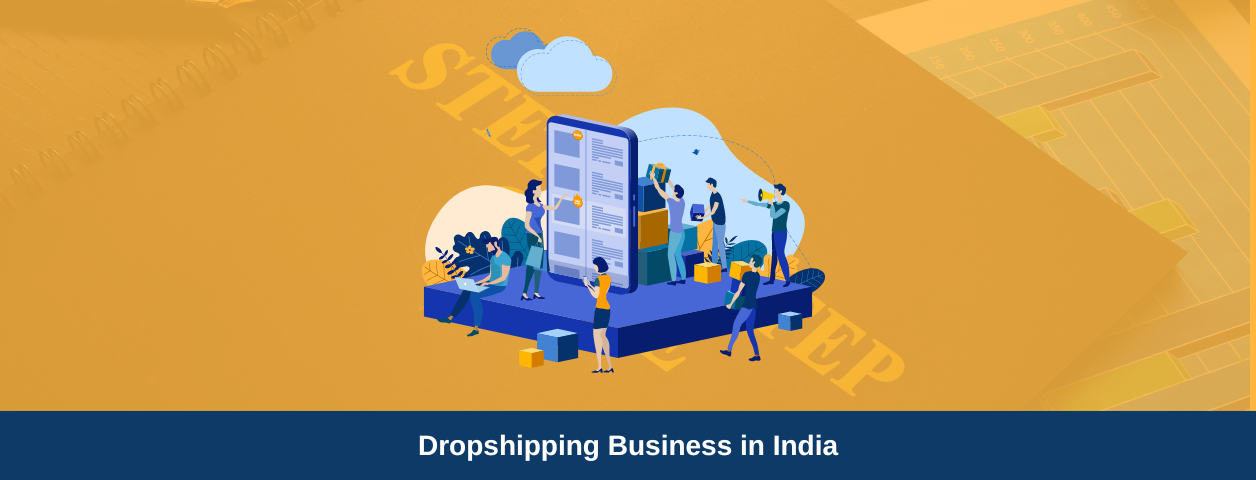DTG vs DTF vs Vinyl printing – picking from one of these popular printing technologies could be a task.
All printing technologies come with benefits and some limitations. However, you can run a profitable business with the proper knowledge and understanding of these printing technologies.
Understanding the many printing processes available will help you make a well-informed decision, whether you’re a creative entrepreneur or someone wanting to personalise your products.
In this blog post, we’ll delve into the world of DTG (Direct-to-Garment), DTF (Direct-to-Film), and Vinyl Printing, exploring their features, benefits, and potential for the future of print-on-demand.
Let’s begin!
Direct to Garment (DTG) Printing: Adding vibrancy to your creation
What is DTG printing?
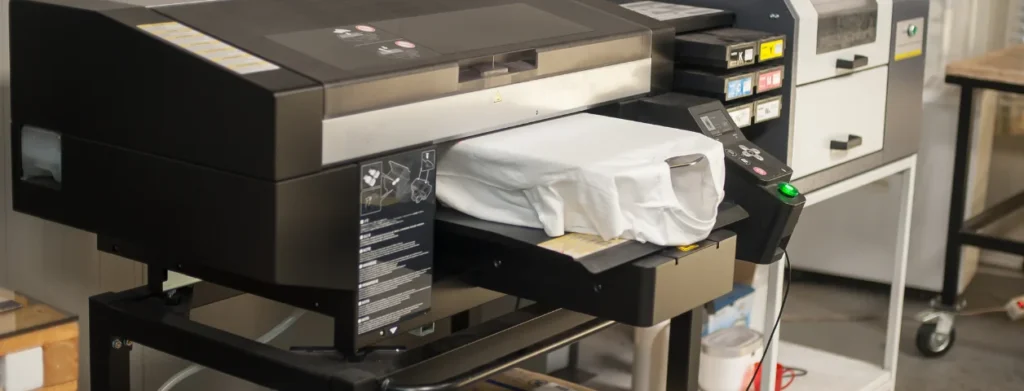
DTG, or Direct to Garment, is a digital printing technology that uses a specific printer to apply ink directly to a garment. DTG enables full-colour printing with just one pass.
One of the primary benefits of DTG is its capacity to generate high-quality, accurate pictures. Because the ink is applied directly to the clothing, the finished product is soft and natural, as opposed to the rigid or rubbery texture of Vinyl.
DTG t-shirt printing is especially great for smaller orders. For smaller runs, DTG is more cost-effective than conventional screen printing.
How DTG works?
DTG printer works in 3 steps which sounds easy yet requires years of expertise
- Firstly, the fabric is pre-treated with a liquid that is an adhesive to the ink.
- Then, the garment is loaded on the platen, and the ink is sprayed as per the design.
- The apparel is heat pressed or cured for long-lasting print.
Benefits of DTG printing
Vibrant Colours: DTG printing allows for a wide range of colours, making it great for generating eye-catching graphics.
Detailed Prints: DTG printing’s sophisticated inkjet technology offers accurate and complex details, capturing every element of your design.
Soft Touch: DTG printing uses water-based inks that enter the cloth, resulting in designs that are comfortable to wear.
Flexibility: DTG printing is versatile since it is used on various fabrics, including cotton and cotton blends.
Direct to Film or DTF Printing: Versatility and ease of use
What is DTF printing?
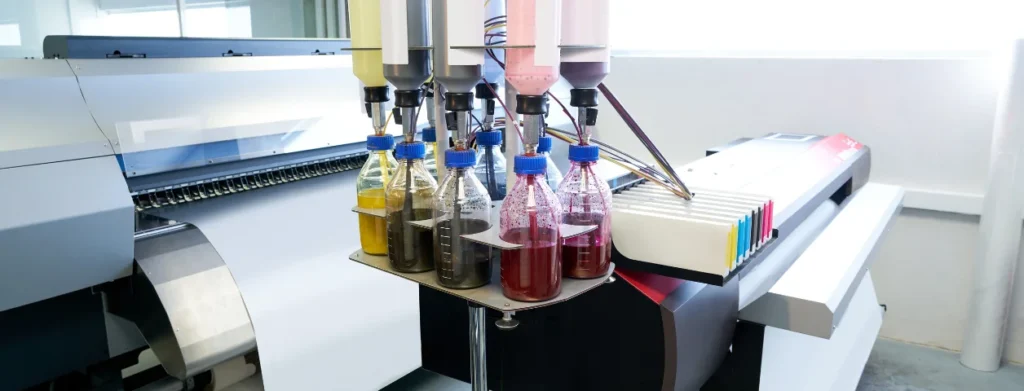
DTF printing, or Direct Film printing, has grown in popularity recently. DTF printing is also a cost-effective technology because of the cheap cost of supplies and equipment.
DTF-printed designs are all durable; they will not fracture or stretch. With careful maintenance, a DTF print may last for a long time. Starting with DTF printing is significantly less expensive than starting with direct-to-garment (DTG), allowing you to maximise earnings while keeping costs down.
DTF printing is not limited to fabric; it can be applied to a wide range of materials, such as ceramics, wood, and more.
How does DTF work?
You can print garments in the shortest time compared to all other printing methods, although the process seems lengthy.
- Your designs are sprayed using water-based inks on a unique transfer film.
- A thin layer of adhesive powder is coated on the ink.
- The design is then heat pressed on the garment at a high temperature to transfer the design to the garment.
Benefits of DTF printing
Versatility: DTF printing is versatile since it can be used on various surfaces, enhancing the possibilities for customisation and personalisation.
Vibrant prints: Prints are bright and long-lasting thanks to the eco-solvent inks used in DTF printing.
Wash resistance: DTF prints have exceptional wash resistance, ensuring your graphics’ endurance.
Light and dark prints: DTF printing allows you to print on both light and dark backgrounds, giving you more design possibilities.
Vinyl printing: durability and precision
What is Vinyl printing?
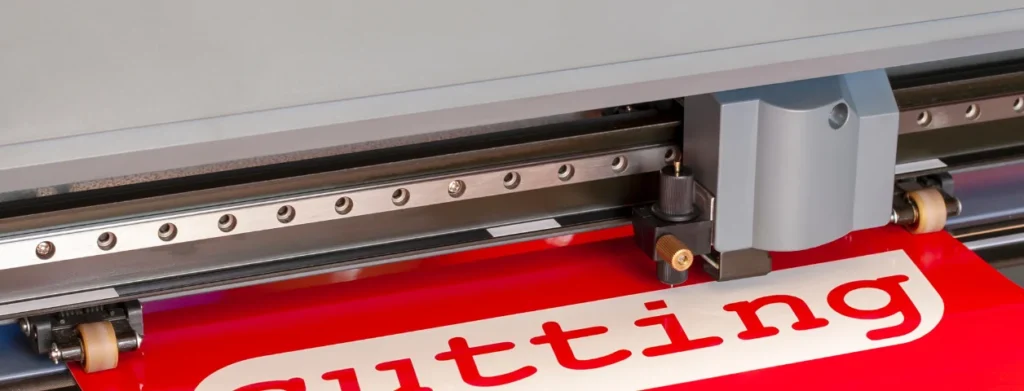
Heat transfers (HTV printing or heat transfer vinyl) are a tested way of adding basic design to clothes. Millions of sporting jerseys have had vinyl writing and numbers applied to them.
DTF printing and heat transfer vinyl has revolutionised the industry lately due to their versatility, lower investment barrier than direct-to-garment (DTG) printing, excellent print quality, and short turnaround times.
It is commonly used to create personalised apparel, promotional items, and signage.
How does vinyl printing work?
Vinyl comes in various colours, patterns, and designs, ranging from simple solid colours to shimmering, reflecting materials and even sparkly alternatives.
- An eco-solvent printer prints your designs on a special heat vinyl sheet.
- Then using, a Vinyl cutting plotter to cut along the contours of the artwork.
- After the printing and cutting, the design is heat pressed onto the garment.
Benefits of HTV or vinyl printing
Durability: Vinyl prints are highly durable, making them perfect for clothes and objects that are washed frequently or subjected to severe wear.
Precision: Because Vinyl printing produces detailed graphics with clean lines, it is ideal for complicated logos or writing.
Colour variants: Vinyl comes in various colours, including metallic and glitter variants, providing limitless possibilities for artistic creations.
Easy application: Vinyl printing is simple, making it accessible to people with little printing expertise.
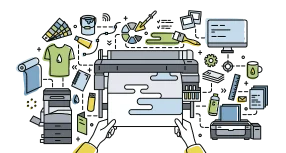
DTG vs DTF vs HTV Printing
A detailed table explaining the differences, features, advantages, and application of DTG (Direct-to-Garment), DTF (Direct-to-Film), and HTV (Heat Transfer Vinyl) printing processes below
S.No | Printing Technology | DTG (Direct To Garment) | DTF (Direct to Film) | HTV (Heat Transfer Vinyl) |
1 | Printing Process | Inkjet technology sprays ink directly to the cloth. | Heat and pressure are used to transfer a special film to the garment. | The garment is heat pressed with pre-cut vinyl graphics. |
2
| Production Speed | Slower procedure, particularly for complex designs. | For complicated designs, it is faster than DTG. | Rapid manufacture, especially for basic designs and large volumes. |
3 | Fabric Compatibility | Light-colored 100% cotton or cotton-blend textiles are ideal. | Suitable for a wide range of fabrics, including cotton, polyester, and mixes. | Cotton, polyester, nylon, and other materials are compatible. |
4 | Color Limitations | The colour brightness and detail are excellent. Prints complex designs with unlimited colours and gradients. | Capable of creating brilliant colours, but with colour accuracy and gradient limits. | Only solid colours are available, and elaborate multi-colour patterns are not possible. |
5 | Durability | It is durable. However, it may fade over time and with regular washing. | It is long-lasting and resistant to fading and cracking. | It is well-known for its exceptional resilience, even when washed frequently. Fading, cracking, and peeling resistance. |
6 | Complexity of Design | Suitable for complex patterns such as pictures and elaborate artwork. | Designs with moderate intricacy and plain colours work well. Not suitable for intricate artwork. | Simple patterns, text, and basic forms are appropriate. Intricate or elaborate designs are restricted. |
7 | Fabric Feel | This produces a delicate, breathable print that blends beautifully with the cloth. | In general, it gives the cloth a smooth and flexible finish. | Because of the vinyl coating, the fabric has a somewhat elevated and textured appearance. |
8 | Cost | Small volumes can be cost-effective. Larger volumes are more expensive owing to ink use. | For medium to large numbers, it is cost-effective. | Cost-effective for small to medium-sized volumes. Larger volumes are more expensive because of the expense of vinyl material. |
9 | Image Quality | DTG printing quality – High-resolution prints with precise details and crisp edges are available. | It provides high picture quality but may fall short of the level of DTG printing. | The pre-cut vinyl forms may limit the resolution, resulting in clean vinyl printing images and patterns. |
10 | Customization | Suitable for one-off designs and on-demand printing. | Ideal for medium-sized print runs and customised graphics. | Suitable for mass manufacture of the same design with minimum customisation. |
11 | Durability | Prints last for up to 20-25 washes | Prints are durable too and last up to 20 washes | Vinyl printing is one of the best in terms of durability as it lasts for more than 50 washes |
12 | Environmental Impact | Water-based inks and minimal trash make this product relatively eco-friendly. | DTF necessitates the use of film, which creates waste. | Because vinyl is not biodegradable, it may have an environmental impact. |
13 | Fabric Suitability | It is mainly used for clothing printing. However, it may also be utilised on various fabric-based items. | Suitable for printing on clothing and hard surfaces such as ceramics, wood, and metal. | Widely used in clothing, accessories, and promotional items. Also suitable for use on hard surfaces. |
14 | Usage in Print on Demand | Because of its adaptability, quality, and on-demand capabilities, DTG is a popular choice for print-on-demand. | Suitable for medium-sized print-on-demand enterprises that can handle big orders. | Ideal for modest print-on-demand enterprises with basic designs and low volumes. Provides quick manufacturing for order fulfilment. |
Advancements and possibilities in print on demand
The print-on-demand world constantly changes due to technological improvements and rising demand for customised products. Here are some exciting enhancements and future potential for DTG, DTF, and Vinyl Printing:
Colour accuracy improvements:
Manufacturers continually attempt to enhance colour accuracy in print-on-demand technologies, ensuring that the finished prints closely resemble the original drawings.
Faster production times:
As technology advances, printing equipment becomes more efficient, resulting in shorter production times. It enables more rapid turnaround and higher output.
An expanded variety of printable materials:
The future of print-on-demand may introduce an expanded variety of printable materials, offering new options for customisation. Manufacturers may submit materials such as sustainable textiles, biodegradable plastics, and others that can be printed, opening up new avenues for personalised designs.
Augmented reality (AR) integration:
With the rising popularity of augmented reality, print-on-demand goods may contain AR components. Customers might interact with printed patterns via smartphones or other devices, creating a new element of interactivity and engagement.
Personalisation and customisation choices:
Demand for personalised items is increasing, and print-on-demand services are anticipated to expand customisation options. It might incorporate personalised size, bespoke patterns, and the opportunity to personalise designs with names or messages.
Enhanced sustainability:
As environmental issues remain a priority, developments in sustainable printing techniques and materials may be seen in the future of print-on-demand. It might include using environmentally friendly inks, recyclable textiles, and more efficient manufacturing procedures.
Integration with prominent e-commerce platforms:
Print-on-demand service integration with popular e-commerce platforms may become more simplified. Businesses and consumers can effortlessly integrate their online storefronts with print-on-demand services, streamlining the order fulfilment process.
What is better quality DTG or DTF?
When comparing the quality of DTG (Direct-to-Garment) vs DTF (Direct-to-Film) printing, various aspects must be considered to determine which approach best suits your individual needs.
DTG printing is well-known for producing vivid and detailed prints. DTG printers will penetrate the fabric using water-based inks, producing vibrant colours and patterns with intricate details, gradients, and shadows.
DTG prints provide a smooth and pleasant feel since the ink is integrated into the fabric, keeping the original texture and breathability. DTG printing is, therefore, a good alternative for designs requiring precise details and a soft feel on cloth.
DTF printing, on the other hand, is distinguished by its colourful and robust prints. The design is printed onto a specialised film and then transferred to the selected material with a heat press.
This transfer method provides excellent ink saturation, producing eye-catching graphics with vibrant colours, especially for more significant pieces. DTF printing extends beyond textiles and may be used on cotton, polyester, and non-fabric surfaces such as ceramics and wood.
Consider aspects such as the intricacy of your design, the intended aesthetic, the kind of fabric or material, and the unique project needs when evaluating which approach may be superior in quality. DTG printing is ideal for fabric patterns since it reproduces delicate details with brilliant colours and a velvety feel. DTF printing, however, is perfect for bright and colourful prints that can be used on various surfaces.
Finally, the choice between DTG and DTF printing comes to your demands and tastes. It is advised that you engage with a printing specialist who can advise you based on their knowledge and assist you in determining the best alternative to obtain the desired quality and outcome for your project.
Conclusion
Finally, the print-on-demand world offers limitless customisation and personalisation opportunities. Whether you pick DTG, DTF, or Vinyl Printing, each method has its own set of benefits and is constantly growing to meet the needs of a broad market.
Exciting advances are on the horizon, including enhanced colour accuracy, quicker manufacturing, and increased material alternatives. Using the proper printing process, you may bring your creative concepts to life and leave a lasting impact.
Read more
- What is DTF Printing? Process Explained Step by Step (FAQs Answered)
- Custom Embroidery – Elevate Your Brand with Custom Designs
- What Makes A Good Logo Design & How To Design It?
- DTG vs Screen Printing – Which Method Reigns Supreme for Your T-Shirt Business?
- Beyond the Basics: How to Print T-Shirts? – Advanced Techniques
Frequently Asked Questions
Which printing method is best for printing on t-shirts?
DTG t-shirt printing is often the preferred choice for t-shirts because it produces vibrant, detailed designs on fabric. With DTG printing, water-based inks are directly applied to the material, allowing for intricate designs with gradients, shadows, and fine details.
The colours are vibrant and long-lasting, resulting in high-quality prints that are soft to the touch and comfortable to wear. It makes it ideal for creating personalised t-shirts with custom designs.
Is vinyl printing suitable for mass production?
Depending on the equipment and resources available, vinyl printing may be used for small-scale and large-scale production. Cut patterns from coloured vinyl sheets and heat-press them onto various surfaces to make vinyl prints.
This approach produces exact drawings with crisp lines and details, making it suitable for producing promotional goods, personalised clothing, and signage. Vinyl printing can handle diverse production scales, whether you require a few products or a considerable quantity.
Are there limitations to DTF printing?
When printing fine details or complicated designs with various colours, DTF printing may have limits.
- Due to the film transfer process, certain design features may not transfer as accurately as other printing processes.
- Simplifying designs and eliminating extremely minute details are advised for best DTF printing outcomes.
- On the other hand, DTF printing specialises in producing brilliant, durable prints with bold colours and more significant design components.
- It is versatile for various materials, although there may be better choices for designs that require delicate details.
Is DTG printing compatible with all fabrics?
The cost of each printing process varies based on criteria such as the intricacy of the design, the number of things printed, and the printing equipment utilised.
DTG printing is generally more expensive upfront because specialised printers and inks are expensive. However, it has the benefit of making very detailed and bright prints, particularly in smaller quantities.
Because the film transfer technique allows for speedier manufacturing, DTF printing is often more cost-effective for more significant numbers.
How does the cost of each printing method compare?
The cost of each printing process varies based on criteria such as the intricacy of the design, the number of things printed, and the printing equipment utilised.
DTG printing is generally more expensive upfront because specialised printers and inks are expensive. However, it has the benefit of making very detailed and bright prints, particularly in smaller quantities.
Because the film transfer technique allows for speedier manufacturing, DTF printing is often more cost-effective for more significant numbers.
Is DTF printing long-lasting?
Yes, DTF (Direct-to-Film) printing is well-known for its long-lasting effects. The design is printed onto a specialised film using eco-solvent inks before being transferred to a suitable material with a heat press.
Its transfer forms a strong binding between the pattern and the fabric or surface, resulting in prints that can endure repeated washing and use. If properly cared for, DTF prints may retain their colour and quality for a lengthy period.
Can you use DTF on cotton?
DTF printing is suitable for cotton and cotton-blend materials. Cotton is an excellent choice for DTF printing because inks adhere well to natural fibres, producing bright, long-lasting prints.
DTF printing, on the other hand, is not restricted to cotton and may be used on various fabrics such as polyester, mixes, and even non-fabric surfaces such as ceramics or wood, providing diversity in application.
What are Vinyl Printing Rates?
Vinyl printing prices vary based on design intricacy, amount of goods, and print size. Vinyl printing is often inexpensive for both small and large-scale production. It has precise and detailed designs, with crisp lines and brilliant colours.
The price may also be affected by the type of vinyl used, such as basic vinyl or speciality alternatives such as glitter or metallic coatings. Engaging with a print-on-demand service provider is best to obtain precise cost information based on your unique requirements and customisation requests.
What are the key differences between DTG, DTF, and vinyl printing in the print-on-demand industry?
DTG printing, as opposed to DTF printing, involves fewer procedures to get the design printed on the garment: First, the garment is pre-treated to assist the ink adhere with the cloth. The garment is then placed on a platen, and the design is sprayed onto the cloth with water-based inks.
DTG is substantially less durable than vinyl. This is because it uses ink that covers the entire garment rather than just the surface. As a result, it’s ideal for outdoor events where attendees will be sweating and moving around a lot.
How do DTG, DTF, and vinyl printing technologies impact the future of print-on-demand businesses?
With the increased availability of digitally printed materials, firms can now make customized products with shorter turnaround times and lower costs than traditional methods. Everything from business cards to billboards and even clothing items may be custom-printed using these current processes.
The future of advanced print technology is far-fetched, embracing innovative media and communication waves that surpass imagination.
Which printing method offers the best quality and durability for print-on-demand products?
Every printing technique is unique due to its style and outcome. DTG is the most long-lasting and direct method of printing any design on a t-shirt.
Can you explain the potential trends and advancements in DTG, DTF, and vinyl printing?
Digital printing has emerged as a major changer in the commercial printing business. Unlike traditional offset printing, which requires printing plates and long setup times, digital printing allows firms to print on demand with short turnaround times and low setup costs.
What are the pros and cons of each printing technique for the evolving landscape of print-on-demand?
Pro’s of DTG printing – High quality, unlimited colors, quick turn-around time.
Cons of DTG printing – Costly, can be printed only on 100% cotton fabrics
Pros of DTF printing – Unlimited colours, vibrant printing, cost-effective
Cons of DTF printing – wastage of film rolls
Pros of vinyl printing – durable, waterproof, scratch-resistant inks
Cons of vinyl printing – Over time and with frequent washings, vinyl heat presses will crack and peel.
You can read in detail about the pros and cons of each printing technology in this article above.

